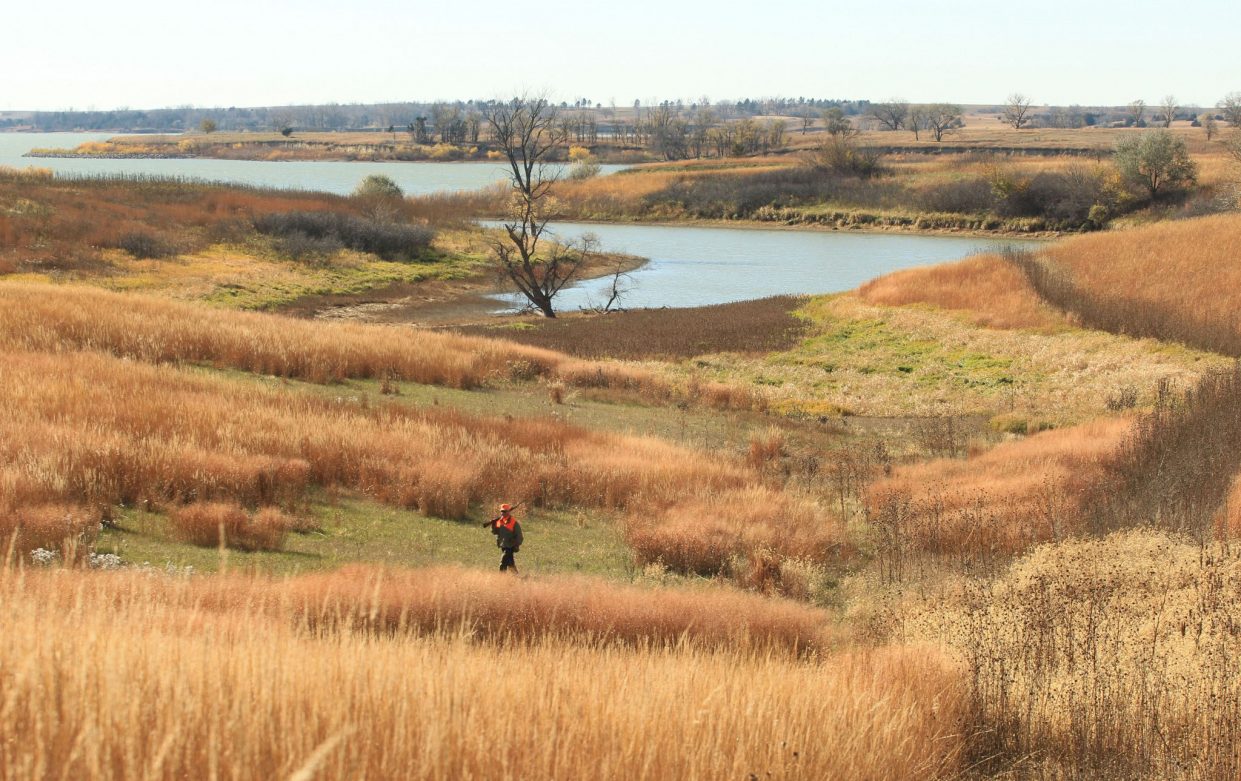
By Julie Geiser
Nebraska Game and Parks Commissioners and staff are in the midst of the Rooster Roundup — a quest to hunt pheasants on public land throughout Nebraska. The first stop on their journey is described below.
The morning was a typical fall Nebraska morning as hunters hit the field at Sherman Reservoir Wildlife Management Area (WMA) for pheasant hunting.
Pheasant and quail numbers are up this year providing upland game hunters with plenty of opportunities to get out and walk many of the public hunting areas across the state.
Sherman Reservoir WMA has about 3,600 acres of public access and excellent habitat that houses pheasants, quail, turkey and deer.
Our guide for the day was Mark Feeney, the biologist responsible for wildlife and the habitat at Sherman WMA. Along with Mark were Nebraska Game and Parks Commissioner Lynn Berggren and friends Mike Bell and Butch Smith from Broken Bow.
We began our hunt on Trail six of the WMA where the native grasses were tall and lush due to good early rains this spring. The thick, natural grasses provide excellent cover for pheasants and quail.
During our hunt Commissioner Berggren commented several times about the amount of cover, food plots and other plantings that have been done at the WMA for wildlife; he was amazed at the amount of pheasants and quail on the area.
The population of pheasants and quail in Nebraska has increased this year due to several factors; good rains early in the spring brought growth of natural grasses and forbes to many areas. The good habitat created prime nesting cover for pheasants and quail alike. During the hatch a good number of insects and plant seeds were available for chicks to advance them into adulthood.
At Sherman WMA, Feeney’s management objective is geared toward pheasants. Planting food plots of milo and wheat are done. Milo provides food, cover and winter loafing areas for birds and deer; it is a drought tolerant plant providing needed protein and carbohydrates for upland birds.
Cedar tree encroachment is eliminated by spring and summer prescribed burns at the WMA. In some shelter blocks and linear belts that have been planted on the WMA, female cedars are taken out leaving only the male trees, which provide additional cover for birds and deer.
Grazing and light disking is also done to stimulate native grasses of switch grass, Indian grass, big and little blue stem, side oats and blue grama. Managing the area with all these tactics also brings natural annual plants like foxtail, sunflower and ragweed along with various forbes giving pheasants and quail what they need to survive this winter and into the breeding season next spring.
Traveling through the WMA some areas were so thick I know we were passing up tight-sitting birds -there was no way our small hunting party was going to cover this large stretch of ground.
Heading south through trail six we already had three pheasants and a few quail harvested along with a customary few misses. At that point another Game and Parks Commissioner joined the hunt; Bob Allen and his two dogs teamed up with the rest of us for the remainder of the hunt.
Bob brought his two dogs, which was a great asset as the cover was so thick dogs were a definite advantage. We had two dogs with us already, but two more made the odds of finding downed birds better.
Hunting in the traditional line with the wind in our faces we hunted hills and valleys of tall native grasslands that lead into food plots of milo and block plantings of lilacs and plumb, cedars and other vegetation. Always on guard as you never knew when the dogs would point or flush birds from cover.
One valley produced a number of hens that burst into the air after being flushed. The word “hens” echoed out so no one would take an unwanted shot.
The scenery and camaraderie made for a great day of upland hunting; hunting like I remember doing in my younger days. The morning of hunting Sherman WMA showed me that upland hunting can be great in Nebraska when suitable habitat is achieved.
At the end of the hunt we had six pheasants and five quail in the bag. We had seen and heard many more birds throughout the morning and had experienced a great day of upland game hunting on a prosperous public hunting area that is uniquely managed for game species.
